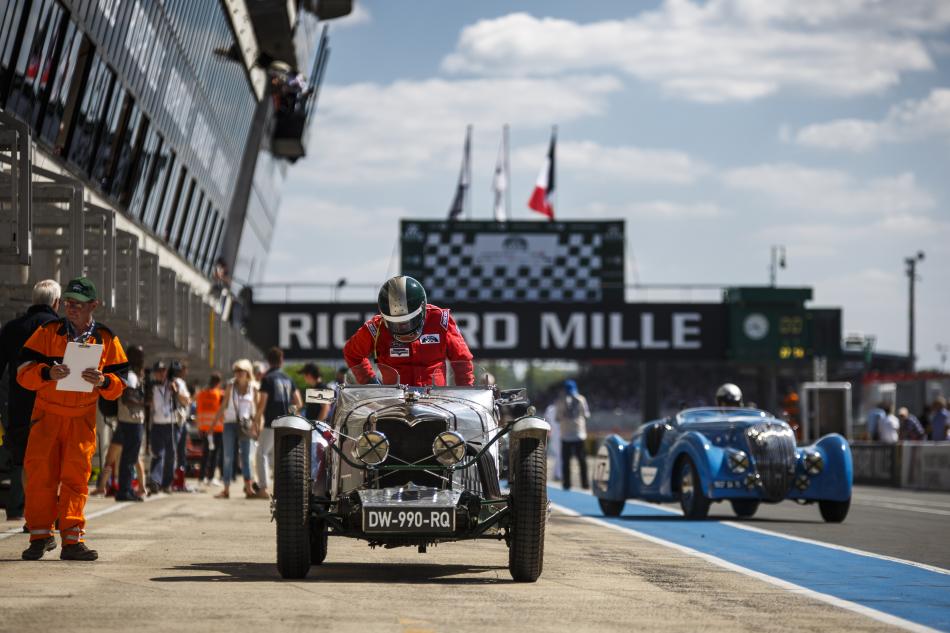Auto #16 - Recipe for a classic
With a plethora of stunning cars and a quality driver line-up, it’s little wonder that the Le Mans Classic is increasing in popularity

There are three hours to go before the flag drops to signal the start of the eighth Le Mans Classic, but the breadth of local motor sport history is already apparent. Neatly arranged in six paddocks separated by eras spanning 1923 to 1981, you’ll find cars produced by Bentley, Porsche, Jaguar, Ferrari, Matra, Lola, Chevron, Maserati and many more of that ilk, marques with a strong Le Mans 24 Hours or endurance racing pedigree. Such are the dominant forces, but in between you’ll find the handiwork of a few oft-forgotten artisans. Inaltera and Moynet might be relative footnotes in automotive history, but remain relevant for the scale of the dreams they once represented. The Le Mans Classic embraces all.
First run in 2002 and since staged biennially at the Circuit de la Sarthe, the Classic runs for 24 hours – but not in the manner of a traditional day-night enduro. Cars are separated into six groups of roughly compatible age and this year’s event attracted 441 starters, the smallest field (1923-39) featuring 64 cars and the largest (1962-65) 79. Each takes part in three races that last 43 minutes and run sequentially from 4pm on Saturday, with short intermissions to allow for recovery and repairs before the flag falls at 4pm onSunday.
Like the Le Mans 24 Hours from which it derives, the Classic attracts a knowledgeable and enthusiastic audience from around the globe, with classic car clubs gathering en masse at the circuit.
Although the crowd was relatively small in the early years, it was this year estimated at 123,000 – a symbol of its growing appeal.
WIDE APPEAL
It isn’t just fans that are drawn, either. The entry featured several Le Mans winners, including Emanuele Pirro, Henri Pescarolo, Marco Werner, Gérard Larrousse, Andy Wallace, Gijs van Lennep, Jochen Mass, Eric Hélary and, perhaps most significantly, Romain Dumas. Three weeks after sharing the winning Porsche 919 in this year’s 24 Hours, Dumas was back to race a 962.
“We are all here for one reason,” says Dumas, “we’re passionate about Le Mans.” Even the Classic’s principal partner took part, with watchmaker Richard Mille sharing the fifth-placed Lola T70 with PSA Group Chairman Carlos Tavares in the 1966-71 race.
“For me, it is the most logical and pleasurable sponsorship,” he says. “My passion is vintage racing cars, I try to race as often as I can, and the period covered by the Le Mans Classic is my favourite.
With this sponsorship I can share this passion with our clients, other car collectors, and I can grab a moment to race one of my cars… My only problem is I am so busy during this event that I cannot race much.”
The event has been organised from year one by Paris-based promoter Peter Auto, headed by Patrick Peter. “There were far fewer historic meetings on the calendar when we launched the Le Mans Classic,” he says. “It was quite complicated, because you have to close a few local roads and we had to convince residents it was worth doing that for something other than the 24 Hours. In 2002, after the first running, all the drivers said they wanted to come back, so...”
It goes without saying that the pace is a little more leisurely than the current qualifying record (3m16.887s, set by Porsche driver Neel Jani in 2015). Christian Träber and Spencer Trenery (Talbot Lago, 5m52.974s) took pole – by 26 seconds! – in the 1923-39 section, while Yves Scemema (Toj, 4m08.292s) did likewise in that for cars from 1972-81. The differences between then and now are aural as well as visual – not just the obvious stuff, such as the raw, mechanical bark of a Cosworth-DFV or the mellifluous yowl of a Matra V12, but also the occasionally fluffed gearshift, the kind of thing electronic guardians disallow in this day and age.
RESTORING A CLASSIC
Many of the participating cars would have telephone-number price tags, should ever the owners decide to sell, but that doesn’t dilute competitive desire. A team of Bentleys attracted much media attention, after being driven to the race from London, racing and then returning once again by road. They weren’t the only ones to adopt this strategy, however. Nigel Wills took an identical approach in his Talbot 90, which bears the registration PL3 – the same as the car that Brian Lewis and Hugh Eaton took to an Index of Performance-winning third place at Le Mans in 1930. Nigel does not, however, pretend his car is something that it is not.
“I’ve owned it for about 35 years,” he says. “I bought it as a pile of bits but it is a true copy of PL3, which disappeared at some point around the Second World War. I thought it would be fun to recreate that car as accurately as one can while being perfectly clear that it isn’t original. PL2 survived, owned by a chap called Pat Stephenson in Cambridge, and he was happy for me to copy every nut and bolt. At about the same time I met a registration plate dealer who was able to supply me with PL3, so we mated the number with a Talbot chassis, a Talbot engine and a Talbot everything else – all the parts are the correct age and year, though obviously there isn’t a continuous history. I spent a long time tracking down the bits, put together a kit of parts – all correct – and recall one of the London dealers saying to me, some years later, that my car has been PL3 for longer than PL3 was PL3, so as far as he was concerned it was PL3!
“I use it for everything – shopping, exploring the Alps, going down to the Mediterranean, driving around racing circuits… Why would I want to put it on a trailer? That would be mad, because Talbots are just brilliant.”
Sharing with John Polson, he was classified 35th – eight places behind another car crafted from boxes of bits, the 1937 Morgan 4/4 of Simon King and Philip St Clair Tisdall. Long a marque aficionado – he bought his first Morgan when he was 21 – King built his 4/4 with a keen eye on the company’s Le Mans past.
“There are two Morgans here,” he says, “and the other one competed at Le Mans in 1938 and 1939. In ’39 they changed the body style significantly, removing the doors and fly screen. There are quite a few differences from how the car was in 1938, when it was raced by Prudence Fawcett and Geoffrey White. That look had been consigned to history and I wanted to bring it back.
“This is a recreation, but the car that raced here in ’38 started off as a road car and that’s why ours looks like it does. It has the same 1100cc Coventry-Climax engine and Meadows gearbox. The components are all correct – we just had to get the details right.
“When I picked it up it was quite literally in boxes, but there were lots of bits we could use. It took two years to get it all done, but fortunately there were lots of good period photos for reference. We had it ready – by the skin of our teeth – for the 2014 Le Mans Classic.
We had to get the FIA paperwork, which wasn’t the work of a moment because not that many cars were built, there was no homologation back then and you have to provide documentary evidence to prove the car was in a particular specification. But the garage that built the ’38 car is no longer there, the factory has no records because it wasn’t their project and all the people involved have sadly passed on, so we could only go by period adverts and other documentation. We were eventually able to confirm everything – and received the papers about three days before we were due to board a ferry.
“It’s a great car and handles really well, as modern Morgans do, although it’s not very quick on the straights. It’s fun, though, because you can corner much more quickly than some of the faster cars and then it’s a case of wondering whether you are far enough ahead before they’ll be able to blast past again.
“It’s all very well putting cars like this in a museum, but I think it’s best for them to be on the track so that people can see what they are supposed to do.”
RESCUE MISSION
Morgan might be a niche manufacturer, but it’s positively mainstream compared with Inaltera (whose name derives from its period sponsor, a wallpaper manufacturer). Built in Le Mans by Jean Rondeau, who in 1980 became the first (and so far only) driver to win the 24 Hours in a car bearing his own name, the company raced at Le Mans in 1976 and 1977, after which the backer withdrew and Rondeau went on to build eponymous sports-prototypes.
In ’76, four-time Le Mans winner Henri Pescarolo shared an Inaltera with compatriot Jean-Pierre Beltoise, the pair finishing eighth overall and winning the GTP class. Forty years on the 73-year-old Pescarolo was back at the car’s helm for the Classic, with Julien Beltoise substituting for his late father (after a strong first race, problems eventually consigned them to 50th). Today, this car is owned by Frenchman Jean-Jacques Cantryn.
“The Inaltera programme stopped abruptly at the end of 1977,” he says, “and I knew the cars had gone to Switzerland. I had no idea where, though. When I moved there in ’83 I decided I’d try to find them. In 1987 I managed to buy one of the cars, but it wasn’t in very good condition – it was exactly as it had finished Le Mans in 1977, with a damaged front wing and windscreen. It took five years to restore it, because there were various problems, but when the owner of the Pescarolo/Beltoise car saw what I was doing he agreed to sell it to me. That was easier to restore because it was in much better condition – the first one had been sitting outside, was full of moss and more or less had mice living inside it…”
Today, that car resides in the Le Mans circuit museum, one of many static exhibits for those who can’t wait two years to savour the past in action.
Click here to read Auto #16 Magazine online.

 Facebook
Facebook Twitter
Twitter






